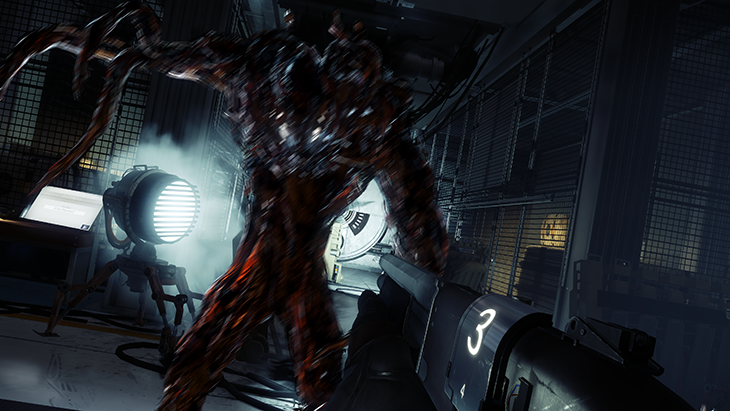Gamers have marched up and down more eerie space station corridors than Alien’s Ripley on Ritalin. From System Shock and Dead Space via Alien Isolation, Space Hulk and The Chronicles of Riddick, most of us have done the hard yards anxiously sprinting passed bits of generic futurist interior design, like Zaha Hadid let loose on Deep Space Nine.
Prey, the latest run-gun-and-get-hopelessly-lost-in-another-bloody-space-station game is heavily influenced by the aforementioned System Shock and Dead Space titles. You’re a guy or girl who finds themselves outnumbered and often out of ideas after your colleagues start doing all kinds of weird experiments on even weirder aliens. Then, as if by magic, it all goes off the rails quicker than Southern Rail’s timetable and the ETs with anger issues are out for blood.
The most common alien species is a spider-like creature that, if being unkind, looks a little like unfinished black biro concept art. Think shiny spider shadows with little detail. But these "mimics" boast the highly entertaining ability to transform into any common-or-garden bit of furniture. So, step into an office and find two waste bins next to each other? The chances are one is about to leap out and kick off.
Are there too many coffee cups on that desk? That chair looks out of place. Why is the rug at a funny angle? These are the type of OCD feng shui questions that you’ll ask yourself when entering a room. It’s different and it works a treat, producing a plethora of edge-of-seat moments alongside furniture false alarms. Mix a bucket of "jump scares" with a soundtrack that drifts between moody, broody John Carpenter and arch, ambitious Vangelis and then – and this is the important bit, thoughtfully mixed-down with great volume manipulation that peaks and troughs at just the right time, and you conjure up a tense claustrophobic sci-fi setting that never lets you settle into a relaxed run and gun rhythm.
Mix a bucket of "jump scares" with a soundtrack that drifts between moody, broody John Carpenter and arch, ambitious Vangelis and then – and this is the important bit, thoughtfully mixed-down with great volume manipulation that peaks and troughs at just the right time, and you conjure up a tense claustrophobic sci-fi setting that never lets you settle into a relaxed run and gun rhythm.
Not settling into the pace of a standard shooter is probably a good thing because the combat is the weakest element of the game. There’s imaginative weapons such as the "gloo" gun – but ammo is generally in very short supply which means you often rely on melee attacks with a wrench that make it very hard to tell when you’ve actually hit one of the nimble mimics. Fortunately by scanning aliens, you can gain access to some of their abilities, which have both offensive and utilitarian purposes – a neat feature, but if you become too powerful you end up being stalked by a super-monster, which in some ways acts as a punishment for simply utilising your character’s abilities.
But where the fighting is underwhelming, the exploration, atmospheric gameworld and environmental puzzles steal the show. The game is at its best when you’re trying to work out how to access a particular area, or reach an essential item. Many of the rooms are designed as giant puzzles and your tools for solving them are based on both weapon choices and unlocked skills. Do you use alien abilities such as morphing or telekinesis or upgrade your human hacking and strength skills to lift heavy objects blocking your path? The choice is yours.
The puzzle elements are a real challenge and a great deal more engaging and satisfying than the combat, a strange conclusion for what is essentially a first-person shooter game.















Add comment